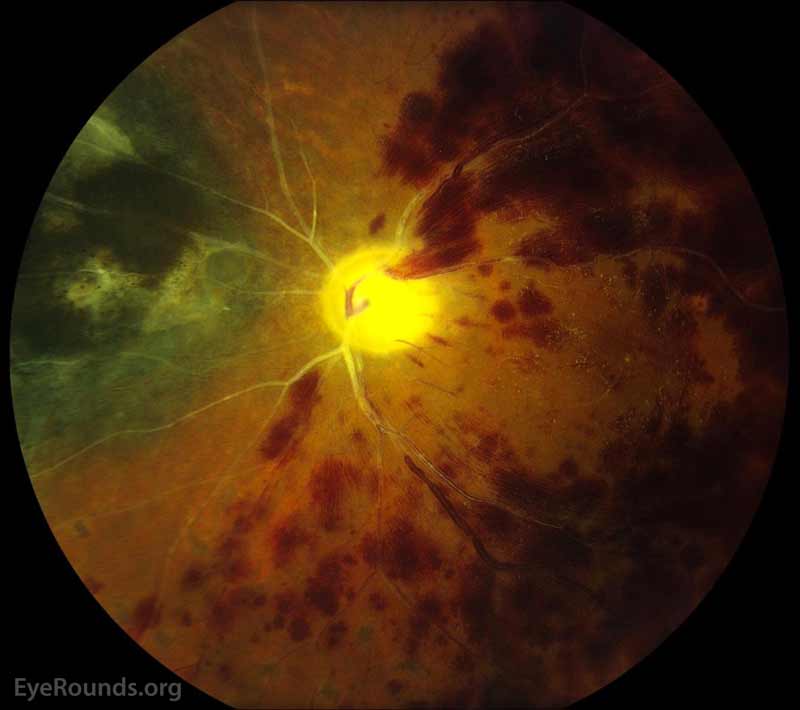Central retinal vein and artery occlusions in proliferative radiation retinopathy
Photographer: Jody M. Troyer, CRA
Echography technician: Laura L. Warner
Contributor: Brittni A. Scruggs, MD, PhD and H. Culver Boldt, MD
posted February 7, 2018
This 74-year-old diabetic man initially presented with an atypical choroidal nevus in the left eye (OS) that had been followed for several decades; this lesion underwent malignant transformation and grew into a 9 x 7.5 x 2.7 mm choroidal malignant melanoma. He underwent iodine 125 (I125) plaque brachytherapy and had tumor involution (Figure 1). Two years after brachytherapy, he developed optic neuropathy and severe radiation retinopathy OS that was managed with intravitreal triamcinolone, with good initial response. However, his visual acuity OS acutely decreased to light perception, and he was found to have anterior segment neovascularization, diffuse retinal hemorrhages, and sclerotic vessels (Figure 2). His exam and testing were consistent with a combined central retinal vein occlusion (CRVO) and central retinal artery occlusion (CRAO), secondary to proliferative radiation retinopathy. He underwent bevacizumab injections and several sessions of panretinal photocoagulation to try to prevent neovascular glaucoma.
The risk of radiation retinopathy and radiation optic neuropathy increase when choroidal melanoma is in close proximity to the optic nerve, the lesion is large, high radiation doses are used posteriorly, a notched plaque is used, or the patient has pre-existing diabetes mellitus [1, 2]. Our patient had all of these risk factors. Neovascularization of the disc and optic neuropathy are seen in ~5% and ~27% of patients, respectively, at five years after plaque therapy for medium sized uveal melanomas [2], and proliferative radiation retinopathy (PRR) has been reported to develop in ~7% of eyes treated with plaque brachytherapy by 10 years [1]. As seen here, PRR can lead to ischemia and severe vaso-occlusive disease [1].
Figure 1. Echography of the left eye pre-operatively (left images) and two years after plaque brachytherapy (right images). The upper images are transverse images centered on 9 o'clock posteriorly (T9P), and the lower images are longitudinal images centered on 9 o'clock (L9). Left images: The pre-operative maximum elevation of the choroidal lesion was 2.7 mm, and the pre-operative base of the choroidal lesion measured 8.0 mm. Right images: 2.2 years after plaque radiation therapy, the maximum choroidal lesion height was 1.4 mm with evidence of involution. The tumor base was unable to be measured by echography.
 |
 |
Figure 2. Color fundus photographs, left eye, 5 weeks after combined CRAO/CRVO. Nasal to the optic nerve, there was a 9 x 7.0 x 1.5 mm elevated, moderately pigmented choroidal lesion with overlying coarse pigmentary changes and drusen. There were panretinal photocoagulation scars in the nasal and superior periphery with persistent, extensive retinal hemorrhages throughout the macula and in the mid-periphery superiorly, temporally, and inferiorly. There was severe, diffuse disc pallor OS with peripapillary hemorrhages temporally and severely sclerotic vessels.
Reference(s)
- Bianciotto C, Shields CL, Pirondini C, Mashayekhi A, Furuta M, Shields JA. Proliferative radiation retinopathy after plaque radiotherapy for uveal melanoma. Ophthalmology. 2010; 117: 1005-1012.
- Boldt HC, Melia BM, Liu JC, Reynolds SM, Collaborative Ocular Melanoma Study Group. I-125 brachytherapy for choroidal melanoma: photographic and angiographic abnormalities. The Collaborative Ocular Melanoma Study: COMS report no. 30. Ophthalmology. 2009; 116: 106–15.



